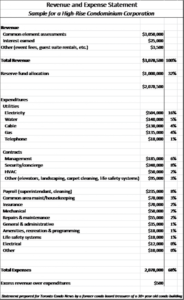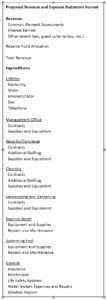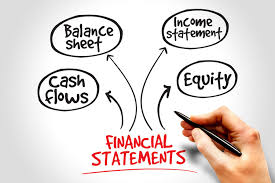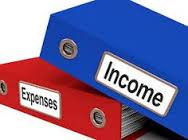 October 2025
October 2025
Condominium corporations are preparing their financial statements in a way that doesn’t allow them to identify how much they are spending in critical areas of their operations.
 Their statements are prepared on a functional basis with individual lines for bank charges, telephone costs and contracts. Yet no condo board or owner can easily identify how much is spent replacing windows, repairing water damage or maintaining the swimming pool. A typical functional Revenue and Expense Statement is shown here.
Their statements are prepared on a functional basis with individual lines for bank charges, telephone costs and contracts. Yet no condo board or owner can easily identify how much is spent replacing windows, repairing water damage or maintaining the swimming pool. A typical functional Revenue and Expense Statement is shown here.
Audited financial statements are required in accordance with the Condo Act. The format, which is flexible, is typically provided in a form recommended by an accountant or management company with little understanding or consideration of a condominium corporation’s decision-making process, or what is important to owners.
Condo management and accountants present in this format because they don’t know any better. Condo boards rely and trust what is given to them rather than providing direction on what they require.
This makes the financial statements of limited use. When making decisions, a condo board is unlikely to refer to them except to obtain an overall perspective on finances. They are unhelpful when making decisions about specific spaces or projects.
The typical Revenue and Expense Statement is unhelpful in providing information that is actionable for the corporation. Does anyone know how much it costs to maintain any particular space in a community? Without this information, it is impossible to know if any space is costing too much to maintain or requires more attention.
Few owners or directors find the financial statements to be of practical use. Presented in a more relatable way, they become more useful in understanding the state of their community. They become more easily understood and actionable.
More useful information would be evident in financial statements organized in the way that condominium communities view their community and make decisions. This means providing information allowing owners and the board to understand what it costs to maintain spaces important to them.
 Condo boards can make financial statements more useful by instructing that they be presented in a more appropriate manner that facilitates decision making. One approach, presented here, is to present expenditures so that amenity costs are better understood.
Condo boards can make financial statements more useful by instructing that they be presented in a more appropriate manner that facilitates decision making. One approach, presented here, is to present expenditures so that amenity costs are better understood.
No single financial report format is ideal – useful in some ways and unhelpful in others. While much more detail is provided elsewhere, the reality is that few read beyond the initial pages nor understand what is provided.
You can’t manage what you don’t measure
You can’t manage what you don’t measure. If it is unclear where or why expenses are increasing, it is exceptionally difficult to identify and correct problems. By focusing on primary expenses and likely problem areas in condominium corporations, it becomes easier to monitor changes in where expenditures are changing, and why.
Financial reports presented in a more practical manner would be more useful to owners and condo boards. At a glance, the reader would understand the cost of maintaining key aspects of the building. On an annual basis, it would be easy to understand which areas of building operations are costing more or less to maintain.
This is a simple problem to fix. Condo boards need to be clear on how they want their financial reports to look. Only then will they receive better financial reporting and tools to improve their decision making.







